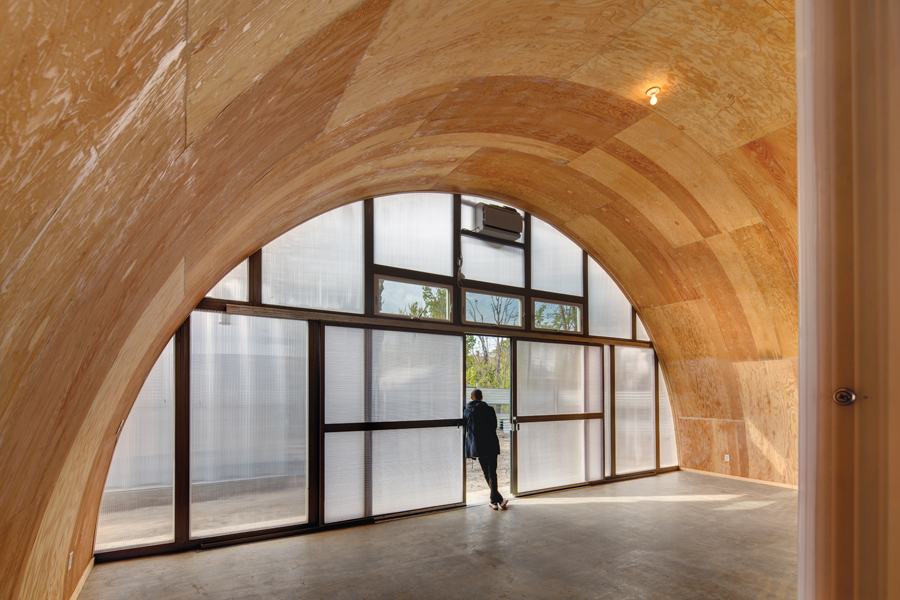It’s certainly getting easier to make the argument that Detroit’s glut of vacant land is as much an opportunity as a problem. In the past few years, we’ve seen all kinds of experimental projects take root on vacant lots — from hardwood tree farms and shipping container homes to an affordable housing tiny house village. Now, add a small community of Quonset huts to that list.
Philip Kafka, a Texan turned New Yorker turned Detroiter, has filled a handful of lots on a mainly empty stretch of Grand River Avenue just west of downtown with a mini-neighborhood of live-work structures that riff on the design of the semicircular, World War II-era steel-frame buildings. They’re minimalist. They’re a little quirky. And apparently, they’re filling some kind of niche (most of the huts landed tenants before the project was even finished). Recently, we chatted with Edwin Chan — the Los Angeles architect who cut his teeth working with Frank Gehry and who designed Kafka’s Quonset hut community — about the promise and challenges of bringing projects like this to Detroit’s neighborhoods.
How did this idea of putting Quonset huts on this site initially hit you?
I think initially, I had reservations about it, because obviously, the Quonset hut is typically associated with army barracks and industrial buildings. So I took it upon myself, and said, well, “What is it going to take to make the huts hospitable and make them a welcoming experience,Ěý as opposed to feeling like you’re going to an army camp?” First, if you look at the conventional way that the huts are deployed in an army barracks, they’re generally very repetitive and there’s no scale to it. So that’s one of the reasons why there is diversity and variety in the huts. There are some that are a little lower, some that are a little wider. There’s a three-story [tall] one — there is no other Quonset hut in the world that is three stories high. And then the second part is they’re placed in a way to define the landscape. What was very interesting about this site is that it’s not very far from downtown, but mentally, you feel like you’re very far away just because there are a lot of empty lots in between. So one of the things I feel really good about is the placement of the huts and the spaces that we sort of created in between the huts. They become like outdoor rooms that are very intimate, private — in a context that is very open.
As you mentioned, this is a part of the city that is fairly vacant, but there are still some historic homes and buildings adjacent to the huts. How did you tackle the challenge of integrating them into the surrounding neighborhood?
Well, this is something that architects are constantly confronted with. Now some architects might say the way to do is it by copying the neighbor: Like, if you’re going to build in a historic city like Paris, you want to make a building that looks like a historic 19th-century building. But I think there are ways to be respectful to your neighbor without imitating. I think if you imitate your neighbor, it’s a little condescending. It’s like a joke. The way I see it is I think we’re being very respectful to the neighbors [with the] scale of the Quonset huts. If you see an aerial photograph, they actually integrate extremely well into the texture and scale of the city and neighborhood — which I actually found very surprising, in a good way. So the hut speaks to the heterogeneity of that neighborhood, and as a result, it doesn’t try to imitate the neighbor. It’s like grandpa and grandson having a lively conversation.
Take us inside: What was your approach to the interiors?
In designing the Quonset huts, we looked at other examples on the internet. And what people have done with other Quonset huts is they try to lay out the interior like it’s a two- or three-bedroom house. So if you look at the floor plan, you wouldn’t actually know it was a Quonset hut: It just looks like a rectangle with hallways and rooms off to the sides. And we have tried not to do that. What makes a Quonset hut beautiful, in my opinion, is the curved profile of the roof form. Now if you immediately put a wall right next to the profile, it’s violating. And you make the Quonset hut look like a typical house, with walls and rooms chopping up the continuity of the curve. So that’s how we arrived at this idea of “islands” — so [in general] the kitchen and the bathroom are all located in the middle of the hut to allow the surfaces to have this continuity and accentuate the shape of hut. That lends itself to a very specific kind of lifestyle. But it’s not a conventional lifestyle. So if you’re looking for a two-bedroom home to raise your kid, that wouldn’t be it.

Now that you’ve toyed with the form of the Quonset huts, do you feel like this project could be replicated elsewhere in the city?
Well, I think we should be a little bit patient and see how people use it. In the end, I think its success is in how people actually inhabit those buildings. Clearly, the reception has been pretty good, but maybe in a year or so, then we’ll have a better understanding of how it actually works in a city like Detroit [and] we can make our next assumption. What is interesting about the project in general, though, is that we’re trying to create an alternative model for urban living, right? That’s essentially what the project is about. And I think a city like Detroit, moreso than other cities, is probably a better canvas. It’s more receptive to this idea than, say, L.A. or New York. A project like this, if you did it in L.A., it would take forever. I think in Detroit there is an energy and enthusiasm. They want good things to happen. So you have a higher probability of success.
We see more experimental developments around the city, but sometimes they feel a little isolated or ad hoc, and it’s hard to see how they fit into the bigger picture. Are there risks to taking this kind of eclectic approach?
Well, like everything, there is a double-edged sword. I’m trained as an architect, so architects like to plan things a little bit. But I think there are very well-defined visions for Detroit in terms of how they see the city growing. So it’s not “ad hoc” in that sense, because there is a big plan in the works. But on the other hand, on the sort of smaller, micro scale, I think good things happen sometimes by accident. So in the context of the bigger plan, I think there also needs to be built into it flexibility for accidents to happen. That’s also the beauty of the situation like what we have now in Detroit is it allows for that kind of improvisation. Like, you want to know where you want to be as a bigger destination. But you should give yourself enough freedom to have fun while you’re getting there.
Edwin Chan is founder of the Los Angeles-based architecture firm EC3. His design for Detroit’s Quonset huts recently earned an Honorable Mention in Architect magazine’s
2017 Progressive Architecture Awards.
 In aĚýHutshell
In aĚýHutshell
Where to see ’em: Grand River Avenue and 16th Street in Detroit. Drive by. You can’t miss ’em.
The Developer:ĚýPhilip Kafka, 30. Former owner of boutique New York billboard company Prince Media. Turned heads in 2015 by placing “Detroit: Just West of Bushwick” and “Detroit: Be left alone” billboards in trendy New York neighborhoods. Also a partner in Katoi — a Corktown restaurant that closed after a suspected arson in February. Kafka lived in one of two “prototype” huts, which have since been demolished.
Specs: Ten huts total, ranging from around 500 to 1,600 square feet. Only the eight on the west side of 16th Street were designed by architect Edwin Chan.
Rent: The 475-square-foot “starter” huts are renting for around $1,000/month.
Amenities: Radiant heat flooring, community outdoor space, and off-street parking. Some units have lofted bedroom spaces and gourmet kitchens.
Etc: These aren’t Detroit’s first huts. In the 1940s and ’50s, Quonset huts were built to house military families (the rent was around $18/month.) And Wayne State University also used huts as temporary classrooms into the 1950s.
|
| Ěý |
|








